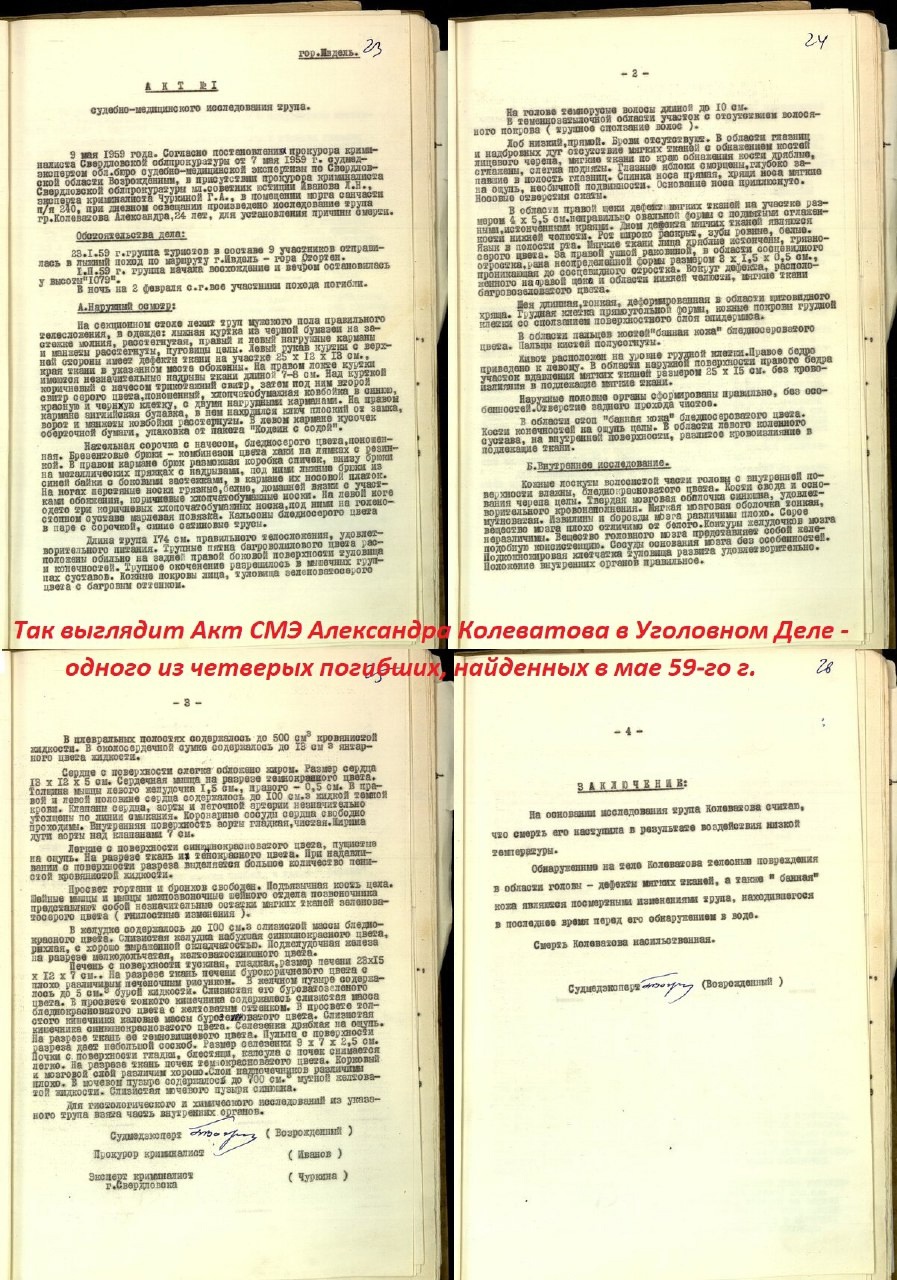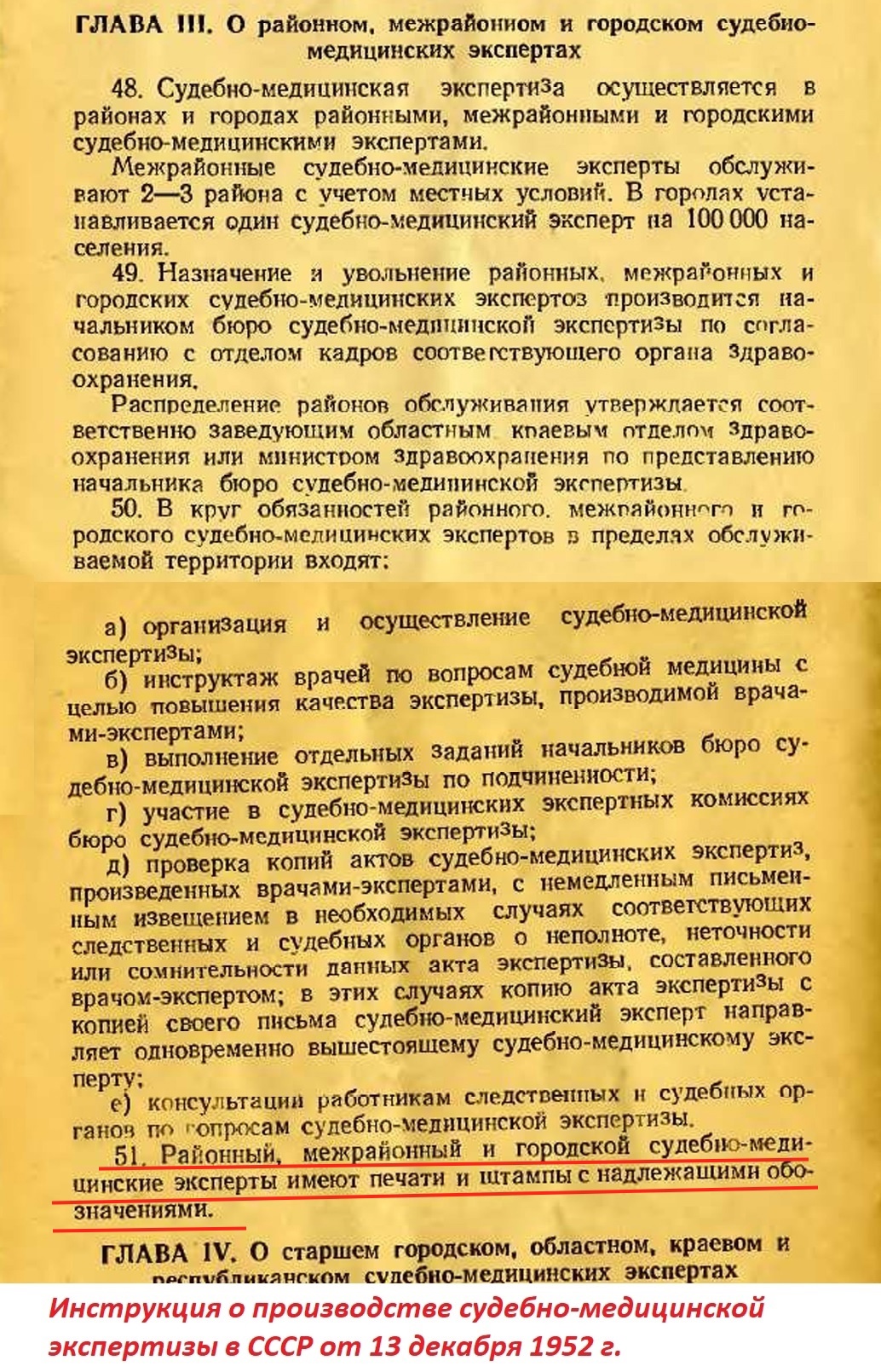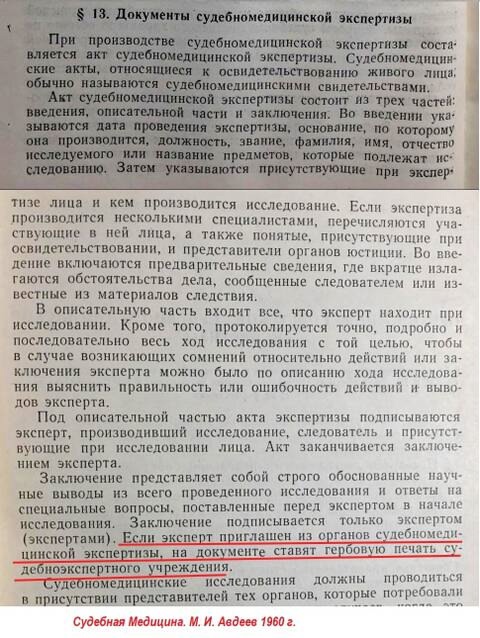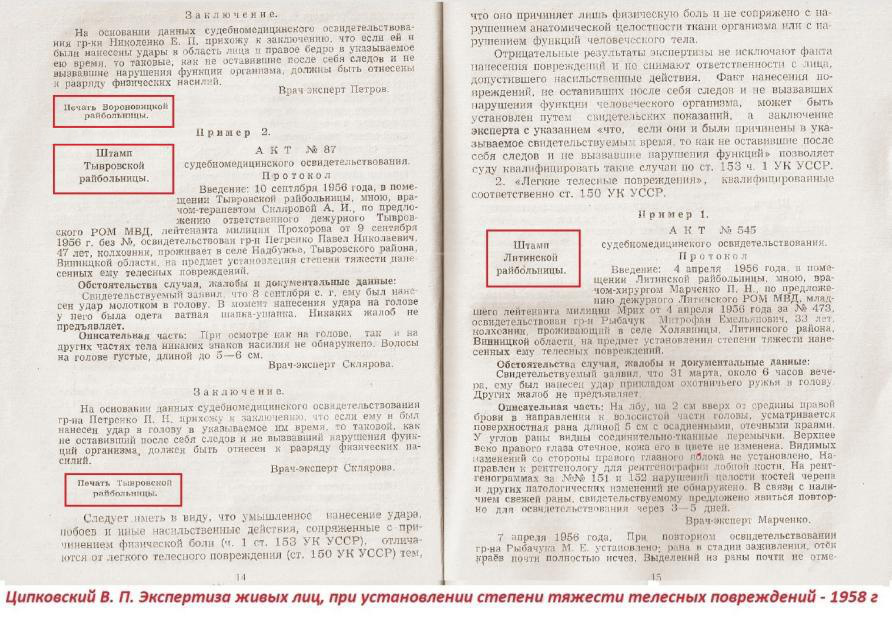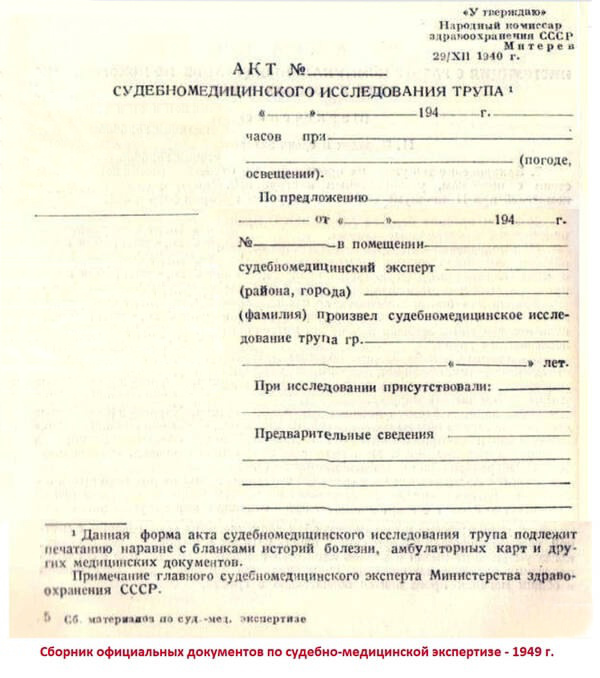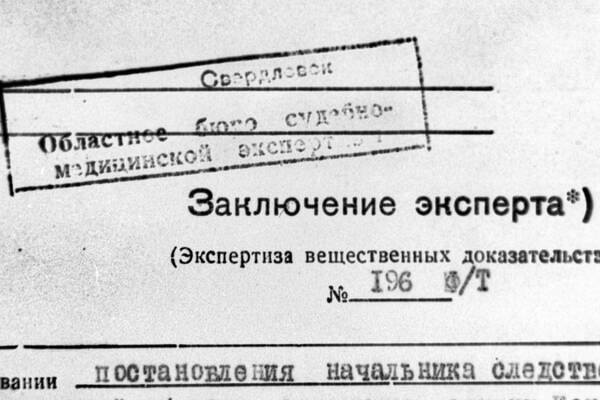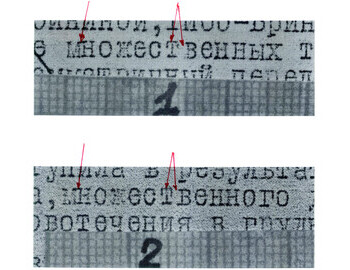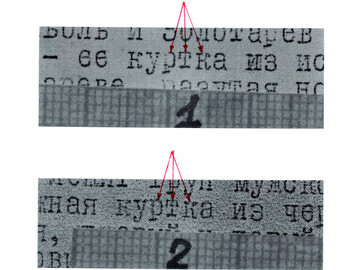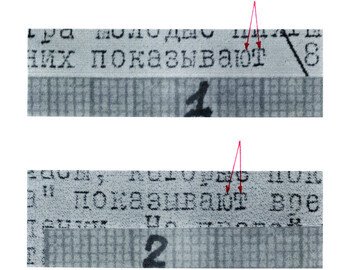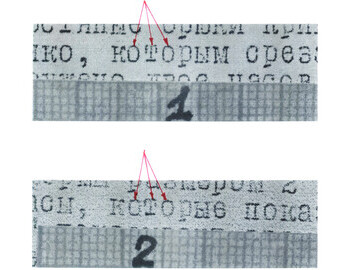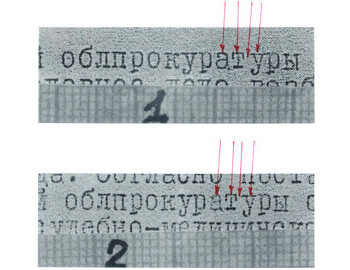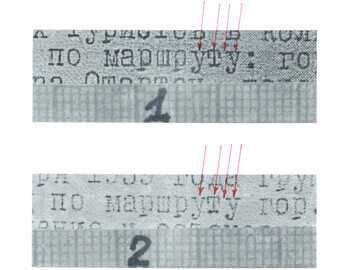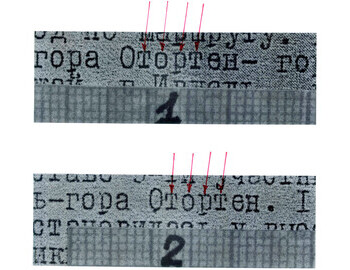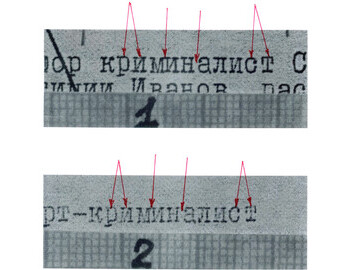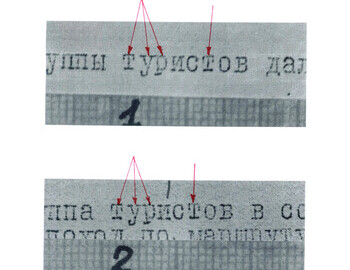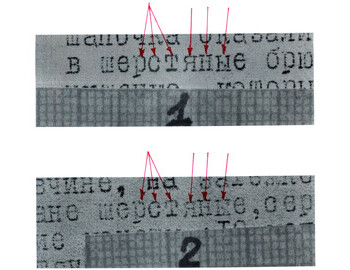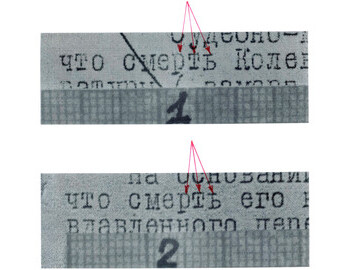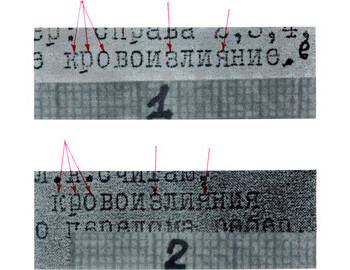
Questions about the autopsy reports of Boris Vozrozhdenniy in 1959
Report by Elena Dmitrievskaya at the 66 anniversary conference, Yekaterinburg. 01.02.2025
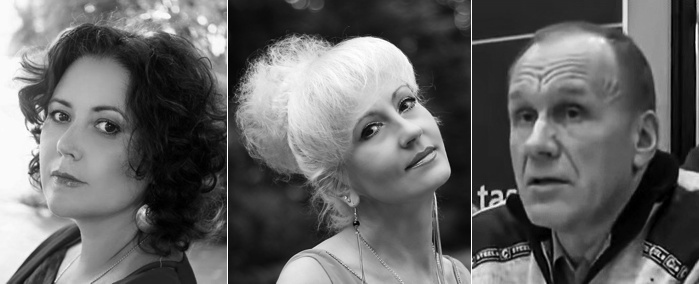
Elena Dmitrievskaya, Olga Litvinova, Vladimir Ankudinov
Special thanks to the leading researcher of the forum "Height 1079" Enson.
Esteemed participants and guests of the conference! In my report a year ago, I asked you to pay special attention to the specifics of the injuries sustained by the Dyatlov group and to the fact that it is a comprehensive analysis of the injuries, including modern research methods, that can give us an answer to what happened on the pass 66 years ago. But today I want to tell you about something else. About the sources that modern forensic experts have to work with. Even for an ordinary person, poorly acquainted with the rules for the writing of medical and forensic documentation, the autopsy reports of Boris Vozrozhdenniy raise questions. Most of the questions concern the medical examinations in May, 1959.
Question one: do the acts comply with the norms and rules in 1959?
Autopsy report of Kolevatov, one of the four dead hikers found in May, 1959.
It is printed on a sheet of paper (instead of a form) and does not contain signatures or seals.
If we look at the instructions for conducting forensic medical examinations at the time (for 1949 and 1952), in the sections "rights and responsibilities of the expert" there are direct indications that district experts had their own seals with their position and the area they served, and regional (territorial) experts, in addition to the seal with their position and the area they served, also had a stamp of the forensic medical institution, with the appropriate designations.
"District, inter-district and city forensic experts have seals and stamps with the appropriate designations."
Instructions on norms in the USSR dated December 13, 1952
- 2 -
There is an indication of the coat of arms seal in the expert reports of Avdeev, who at that time was the chief forensic expert of the Red Army and the USSR Ministry of Defense, and the head of the Central Forensic Laboratory of the USSR Ministry of Defense, from instructions for 1960:
"If the expert is invited from forensic medical examination bodies, the document is stamped with the forensic institution's official seal."
Forensic Medicine M.I. Avdeev 1960
In addition, the Instructions on the production of forensic medical examinations in the USSR also applied to the acts of forensic medical examination of living persons - at the beginning, a stamp of the medical institution was placed, and next to the expert's signature at the end - an imprint of the seal of the same medical institution:
V.P. Tsipkovsky Examination of living persons, when establishing the severity of bodily injuries, 1958.
And if we return to forensic medical examinations of corpses, then the first page of the autopsy report, which is produced by the Bureau of Forensic Medical Examination, is always a standard form on which all the required formalities are printed in typographic form, including the expert's signature. On such a standard form, in the upper left corner, a rectangular stamp of the Bureau of Forensic Medical Examination is always placed, on the last page, near the expert's signature - a round seal:
Collection of official documents on forensic medical examination - 1949
Unfortunately, the acts of the forensic medical examination, in the form of filled forms with seals from real criminal cases, are very difficult to find, since they are intended only for official use, and during that period of time - it is almost impossible to find. But Vladimir Ankudinov agreed to provide us with a corner stamp of the Bureau of Forensic Examination from a criminal case of the 60s
As you can see, in a state forensic medical institution, any expert opinion is issued in the prescribed manner. The opinion is issued in accordance with the regulatory documents approved for these forensic medical institutions by their governing bodies.
What else is missing in these expert reports?
The forensic medical reports do not contain any notes warning the expert about criminal liability for refusing to give an opinion and for giving a false opinion (there are such signatures under the opinions of Churkina and Levashov).
In a criminal case, each expert report must be accompanied by a resolution on the appointment of an examination. But in our Criminal Code, you will not find a single resolution on the appointment of a forensic medical report.
Someone can even give examples of improperly executed reports from other criminal cases during this period. However, we have not a simple passing case, but a case of mass deaths of people, information about which was in Khrushchev's "special folder".
- 3 -
Question 2: Who, when and where printed the forensic medical examination reports?
In March 2021, at the forum "Taina.li", Natalya Varsegova was asked why an examination of the forensic medical examination texts had not yet been conducted to find out what typewriter the forensic medical examination reports of the "last four" were printed on. She replied that it was necessary to know the type of typewriter that was used, and that Kuryakov had restricted access to the case, and therefore it was impossible to conduct such research now.
This answer only increased the suspicions of former forensic expert Vladimir Ankudinov, and he decided to conduct a comparative study of the texts himself. And although he does not have evidence from a forensic expert on the technical examination of documents, since he is a specialist in forensic traceology and forensic ballistics, he is familiar with the methodology of such research, since he himself taught the basics of such research to students when, after retiring, he taught forensic science at one of the law schools in Yekaterinburg. He compared text fragments based on defects in the typewriter mechanism that arise during the operation of the typewriter and are visible in those materials of the criminal case that are known to everyone, both researchers and specialists.
He marked 12 matching features, photographs of which I can offer to your attention so that anyone can check and draw their own conclusions. It would be possible to mark a larger number of matching private features, but this is more than enough:
12 matching features in fragments of the pages from Ivanov's resolution from the supervisory proceedings ("1") and autopsy reports ("2")
As a result of his research, Vladimir Ankudinov came to the conclusion that all four autopsy reports for the "last four" were printed on the same typewriter (the first copies are in the criminal case, the second, "carbon copies" - in the supervisory proceedings), and on the same typewriter on which the first version of Ivanov's resolution on the termination of the case was printed, which was "rejected" and is in the supervisory proceedings. That is, these acts were printed not in the Bureau of Forensic Medical Examination, but in the regional prosecutor's office. Also, Vladimir Ankudinov sent these studies for verification to one of the experts of the Central Ural Scientific Research Laboratory of Forensic Medical Examination, who at one time was engaged in the technical examination of documents. Now, for several decades, typewriters have not been used at all, now everything is printed on computers, and this is a completely different principle of construction and operation of the letter-printing mechanism. There are very few experts working today who specialize in studying texts written on typewriters (during the Soviet era). So, studying typewritten texts was also the profile of that expert (his name is known, but it will not be mentioned here) whom Vladimir Ankudinov contacted, and he fully confirmed the correctness of his conclusions. The forensic medical examination reports of the May four bodies are not the originals of the reports that were issued to the prosecutor's office in the Sverdlovsk Regional Forensic Medical Examination, and not even copies of documents that have the proper certification and can be unconditionally referred to, but merely reprints of these reports, prepared in the Sverdlovsk Regional Prosecutor's Office, which essentially have no legal force at all.
- 4 -
Question 3: Are there any obvious discrepancies and medical errors in the autopsy reports?
Almost all the acts, including those from March, are full of both gross grammatical errors and gross medical ones, which Boris Vozrozhdenniy himself obviously could not have made, just as the experienced medical registrars who printed these acts could not have made them.
Here are just a few glaring examples of such errors:
Rustem Slobodin's autopsy report conclusion:
"The fracture of the left frontal bone discovered during the internal examination could have occurred..."
This is on a page where there are no signatures. A doctor could not have written this, according to anatomy, this is a fracture of the frontal bone on the left. A person does not have a right or left frontal bone, we have one frontal bone.
Here is also what Galina Sazonova was the first to notice.
"From the anterior edge of the squama of the left temporal bone in the direction forward and upward of the frontal bone area, there is a bone crack with edges diverging up to 0.1 cm, the crack length is up to 6 cm. The crack is located at a distance of 1.5 cm, from the sagittal suture." In an adult, from the temporal bone to the sagittal suture, it is clearly more than 7.5 cm.
"The right half of the face is somewhat edematous, it has many small abrasions of irregular shape of parchment density under a dry crust, partially passing to the chin area." There is no such type of damage - "abrasions of parchment density, under a dry crust." Parchment density abrasions are postmortem damage, and a crust on abrasions is a sign of their healing, in the text one contradicts the other. What happens? One medical term was "lost", an entire phrase was rearranged, and as a result, in just this one sentence from the forensic medical examination, a complete medical absurdity was obtained.
Forensic medical examination of Nikolay Thibeaux-Brignolle:
- "The mucous membrane of the esophagus, trachea, bronchi is bluish-red. The ventricle contained up to 100 cm3 of a mucous mass of a reddish-yellow color. The mucous membrane of the stomach is bluish-red, with well-defined folding. The pancreas..."
How can an expert call the stomach a ventricle, and then write again correctly "stomach"?
More simple mistakes:
Forensic medical examination of Georgiy Krivonischenko:
- "Metacarpophalagic". "I" instead of "E".
- "Middle", instead of "third" finger.
- "On the anterior inner", instead of "on the anterior-inner".
- "On the posterior inner", instead of "posterior-inner"
- "Around the pericardium". "O" is capitalized. Instead of "In the pericardial".
- "Caranary", instead of "coronary".
Forensic medical examination of Yuri Doroshenko:
Errors showing that the typed was not understood.
- "Density", instead of "density" several times.
- "Third", instead of "third" several times.
- "In the right" line, instead of "right".
- "With parchment", instead of just "parchment".
- "On the back internal", instead of "back - internal".
Several times confusion in singular and plural.
- "Thyroid", instead of "thyroid".
- "Adpochneki", instead of "adrenal glands".
Forensic medical examination of Igor Dyatlov.
- "External lateral", instead of "external - lateral".
- "Phalageal" with an error.
- "Liver" is a household word, it should be "liver"
- "Cortex and cerebral", it should be "cortical cerebral", etc.
Modern forensic expert Eduard Tumanov has repeatedly stated that the acts were edited by someone.
"We use only the data that we have, the question is how reliable they are, and how complete they are. As for forensic medical examinations, on the one hand, an incomplete description prevents us from understanding the mechanism of damage formation, and on the other hand, there are doubts about the reliability of the damage description. "
* (The Mystery of Dyatlov Pass: Forensic examination done 60 years ago may not have been carried out completely, Radio KP, March 16, 2019, Time code 01:10)
Sazonov: "Are we coming to the conclusion that somewhere there are documents that we have never seen?"
Tumanov: "And we will never see them, because judging by the conclusions written by Vozrozhdenniy, there are clearly editorial edits, later ones."
* (Dedicated to the anniversary of the Dyatlov Pass tragedy: forensic medical examination data that are difficult to explain. Evgeniy Sazonov, Eduard Tumanov. radio KP, January 30, 2021)
- 5 -
Tumanov about the hyoid bone of Lyuda Dubinina:
“The first part is normal - it is based on when, on what basis, and by whom the autopsy was performed. The second part is the circumstances of the case, which are copied from the resolution. The third part is the results of the external examination, there he describes the hyoid bone, the pathological mobility that he determined during the external examination.
And then - internal examinations. During the internal examination, he should already describe the hyoid bone: that there are hemorrhages in the soft tissues around the hyoid bone, a fracture of such and such a horn is determined, small, large, or both. Or on both sides. But this is not there! It feels like this sheet was replaced. Back then, they typed on a typewriter, now it's easier on a computer. But then, in order to save time and effort, they retyped only one or two sheets, and that's it. And they adjusted the text to size. Do you understand what I'm talking about?.. He was too lazy to retype the first page. He left it there, and himself.. "
I generally have the feeling that this is the second edition, that is, the original text was different.
* (Dyatlov Pass: documentary series #4, Alexander Lukyanov [not for air], Time code 11:02)
Vozrozhdenniy's son-in-law about Lyuda's language:
"MB: Let me pass the phone to my husband, he talked more.
Navig: Hello.
VF: Good afternoon. You know, when my father-in-law was still alive, we were sitting here for some reason, he told me a little about how he flew there with the prosecutor, there were a lot of inexplicable things, like an expert. ...so that the tongue was bitten off or cut off."
* (©OO "INTERNET CENTER of the Dyatlov Tragedy", 2009. Text of the conversation of the "CENTER of Civil Investigation of the Dyatlov Tragedy" (NAVIG), Former Director, TAU forum with Vozrozhdennaya Marina Borisovna (MB) and her husband Viktor Fedorovich (VF) on the Dyatlov case. February 15, 2009.)
Conclusions:
In March, they tried to do as was required by the rules for conducting a forensic medical examination, at least a seal was used and witnesses were invited to the autopsy (even if only formally). Therefore, in the execution of the first five acts, we are talking about the so-called absence of legal obligation. Which made it possible to edit any sheets of the acts on which the signatures and seals were missing.
But the absence of seals on the last four acts, during the autopsy of the May bodies, may indirectly confirm their repeated autopsy in Sverdlovsk, and the reworking of all four examinations on the prosecutor's typewriter. When, during the reprinting, all the unnecessary things were removed, which prevented the blame for the cause of death only on a natural factor. That is, the same thing happened with the last four acts as with the original version of Ivanov's resolution to terminate the criminal case. With the difference that this version was preserved in the Supervisory Proceedings. And it was precisely during the second autopsy that the Bureau of Forensic Examination could decide not to take responsibility for such an illiterate piece of paper from Ivanov, without putting a seal on these illiterate prosecutorial reprints.
What else confirms the assumption that the seals were initially on the last 4 May acts of the Forensic Medical Examination? In addition to the autopsy, they took biological material from the corpses to send for histology. And in this case, it was impossible to do without a seal from the Bureau of Forensic Medical Examination, due to the rules for sending and storing cadaveric materials. After filling the jars, they are immediately hermetically sealed with ground glass stoppers, then wrapped in clean paper, tied with twine or strong thread and sealed with a wax seal so that the jars cannot be opened without breaking the integrity of the seal. That is, when the May bodies were autopsied, Vozrozhdenniy or Ganz were required to bring a stamp from Sverdlovsk to Ivdel.
But the Ivdel autopsy could not satisfy either the prosecutor's office or the party leadership. Neither of them needed these injuries. So the decision to autopsy them again, for the purpose of examination by higher-level specialists, was absolutely reasonable. Therefore, having removed the obvious, which could not be attributed to nature, the forensic medical examination was done anew. That is why the typewriter from the Sverdlovsk prosecutor's office was used, which was proven by Ankudinov. That is why Churkina's name appeared under the acts. A forensic expert was not needed at the autopsy in Ivdel, at that time they still did not really know anything about the injuries. But in Sverdlovsk, when the goal had already arisen to figure out why they actually died, the help of a forensic expert was needed. Hence the subscription that, according to Igor Makushkin, his mother gave to the KGB.
As for the first five acts, here's what else can be said. Where did they, as well as the last four, come from, so many medical errors, at the level of a first-year medical institute? After all, medical illiteracy is definitely observed not only in the last, May, but also in the March acts. That is, in all 9 acts of the Forensic Medical Examination. But based on the information received from Oleg Arkhipov, at that time, in 1959, G.A. Menshikova worked as a judicial registrar in the Sverdlovsk Regional Bureau of Forensic Examination. And she definitely had work experience, since she had worked in Ustinov's work collective since 1952. This illiteracy in all 9 acts at once means only one thing, that all 9 were not printed within the walls of the Sverdlovsk Regional Bureau of Forensic Examination. Printed by a person who was completely illiterate in medicine.
Vozrozhdenniy could not have printed the March autopsy reports himself in the Ivdel morgue without drawing unwanted attention to the stupidities about the "left frontal bone" and "parchment-thick abrasions under a dry crust". After all, Klinov signed these documents, and Vozrozhdenniy had every reason to fear for his reputation as a forensic expert. In this case, there is only one conclusion: Ivanov pulled out some sheets from the March acts, in addition to those already signed, with the seals of Laptev and the N-240, and edited them himself in the right places.
In the March reports, only some sheets were edited, unnecessary things were thrown out of them, hence the appearance of nonsense and confusion in medical terms (when, for example, an unnecessary line or phrase is thrown out of context: threw out the unnecessary, prints the rest according to the text, threw something out again, prints the rest as it is, etc.), plus the medical illiteracy of the author himself.
Conclusion:
All these nine acts, exactly in the form in which we see them in the Criminal Code, have nothing to do with the Sverdlovsk Regional Bureau of Forensic Examination, they were never there. And not only because of the lack of seals, but also because with such blatant medical illiteracy, they were already losing their legal status.

